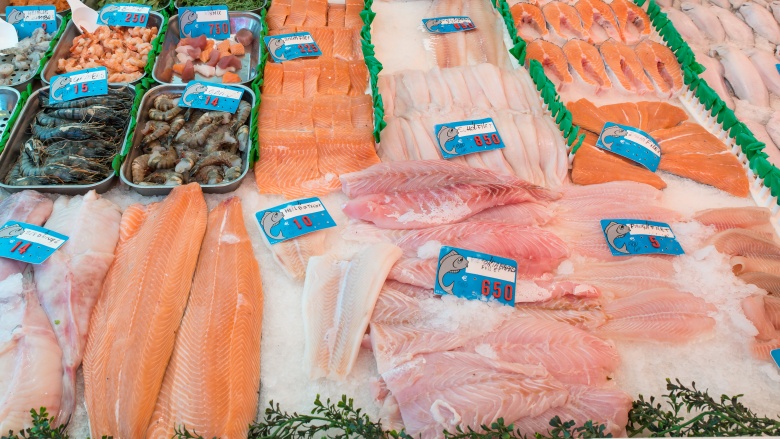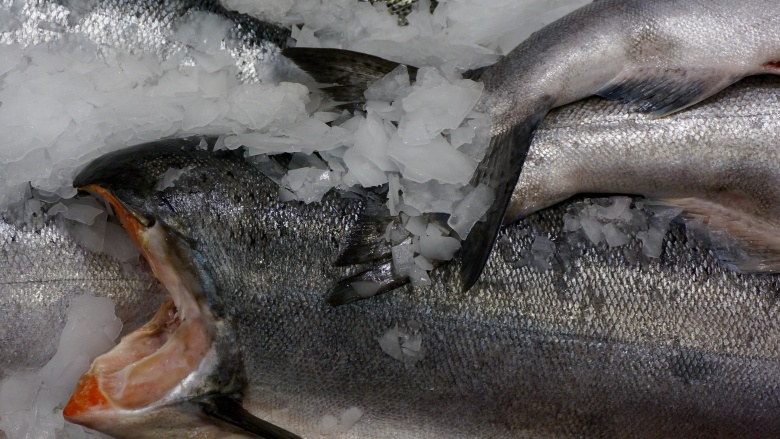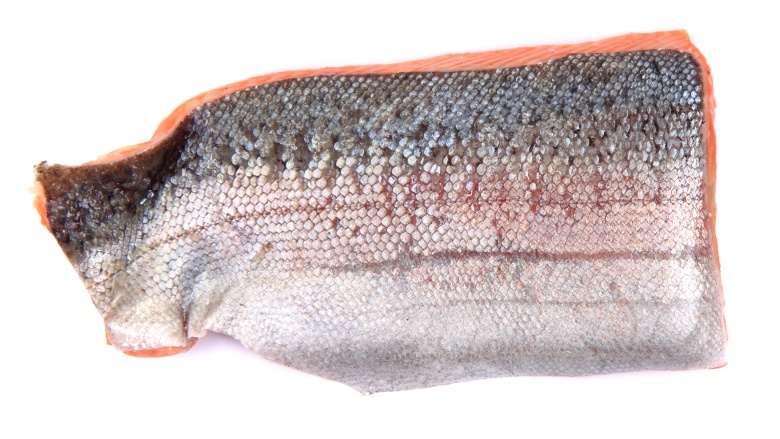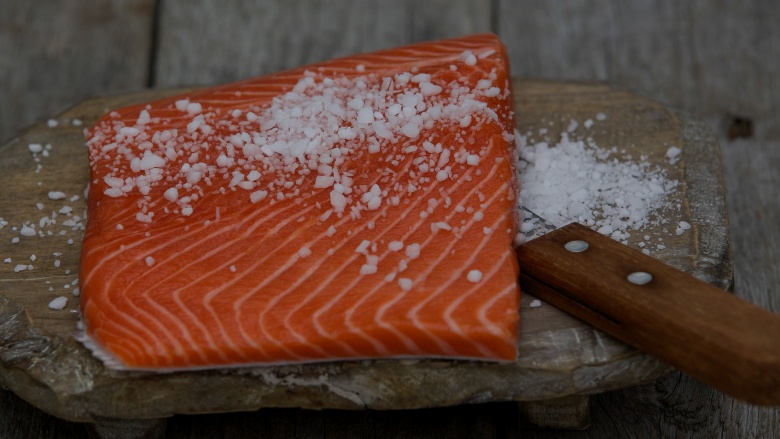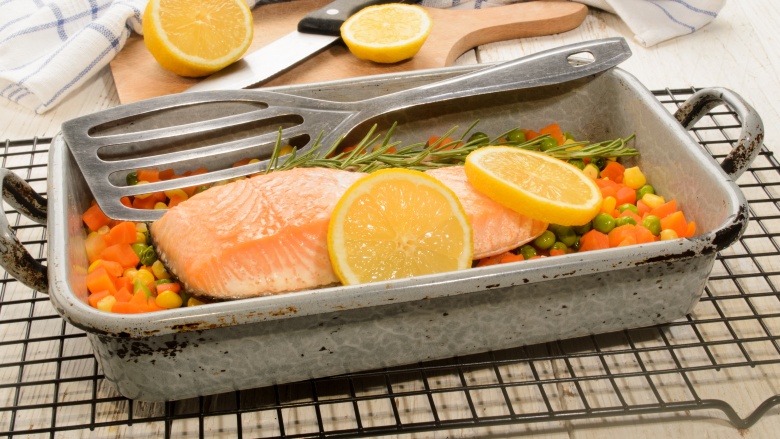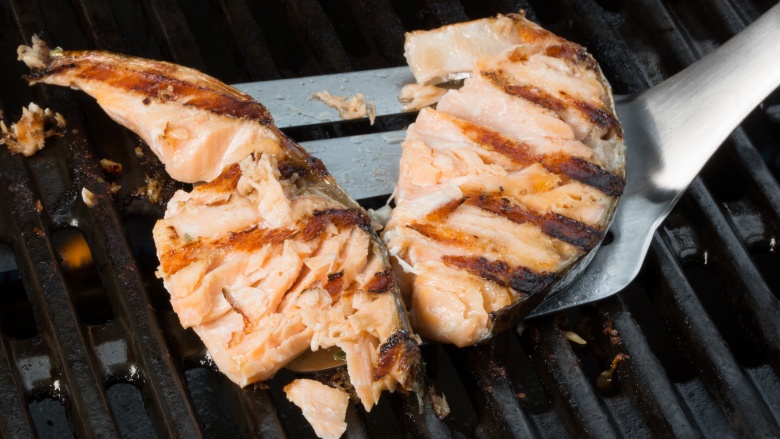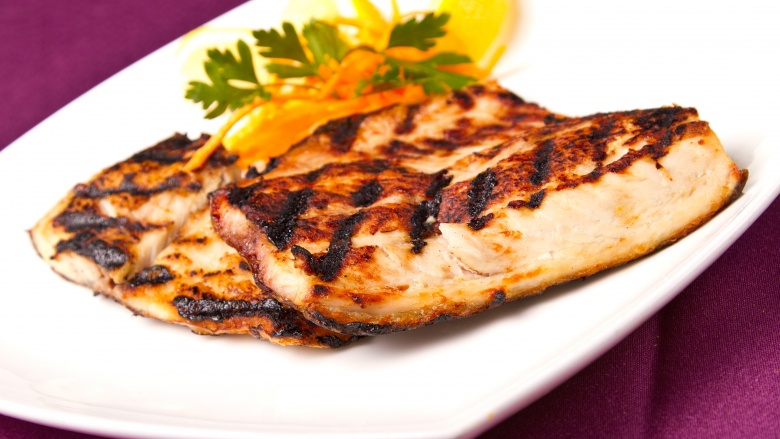8 Mistakes Everyone Makes When Cooking Salmon
Whenever you take some edible ingredients and start messing around with them to make a meal, the possibility of making a mistake is there. It doesn't matter how "easy" a dish is to knock together: apply enough inexperience, overconfidence, drunkenness, bad equipment, or bad recipes, and your quick fix can quickly become a quick trash filler. Salmon makes a good centerpiece for any meal, and a healthy one at that—but on the scale of easy things to cook, salmon is nowhere near the top. However, forewarned is forearmed, as they say, and with that in mind, here are a few common mistakes people make when they cook salmon.
Buying bad fish
Any meal that contains salmon has to start with you actually buying the salmon. And while this can be as easy as grabbing the first bag of frozen fillets out of the freezer section, for the sake of your culinary reputation, you might want to give it a little more thought.
Fresh and unfrozen is always going to be the first choice at the fishmonger, but if you live any distance from the ocean or are shopping out of season, there's a good chance those options may be mutually exclusive. As in so many areas of life and love, it will be to your benefit to first learn something about what you later plan to shove in your mouth.
Checking out the appearance is a good first way to assess fish quality. Different varieties of salmon will have differences in color and flavor, but in general, brighter colors are better than pale ones. As Matt Duckor notes for Epicurious, avoid any fish that looks dried out or has a brown color instead of the uniform bright reds and pinks you're looking for.
Thawing it incorrectly
When you're in a rush to eat but a major ingredient is frozen, it can be tempting to lean on the microwave to kill the cold. And while this might be fine if you're talking about vegetables, this is a huge mistake when it comes to salmon.
Salmon, like most fish, doesn't take much to cook. In fact, applying the correct amount of heat for the correct amount of time is one of the crucial steps when preparing almost any seafood. Use too much, and it's all too easy to make the fish dry and tough. Microwave ovens blast electromagnetic radiation at whatever you have decided to warm up. The frequency of the microwaves produced by a microwave oven get along well with water molecules (as well as fat molecules and sugar molecules), quickly getting them all hot and bothered. Since microwaves pretty much never thaw things evenly and since fish are more sensitive to heat than most main courses, this uneven heating with result in rubbery, dry fillets that you'd be lucky to get your cat to eat.
As a general rule, you want to avoid thawing fish using any heat at all. Opt instead for an overnight stay in the refrigerator (not an option for the quick meal) or a sealed bag under cold running water. This second method will defrost your dinner much more quickly than you might expect, and it won't cook it in the process. After the fish is thawed, it is also a good idea to let it warm up to room temperature before cooking. The colder the fish is before cooking, the more likely you are to overcook the outside before the inside starts to feel the heat.
Removing the skin
There are arguments that can be made in support of both removing the skin of salmon and leaving it on. But whichever way you lean doesn't really matter so long as you don't remove the skin before you cook it.
On most creatures, the skin forms a useful barrier between their insides and their outsides, protecting their most sensitive parts from bugs, germs, and gravity. And this protection is useful even after death. As has already been mentioned, fish like salmon can be pretty tricky to cook just right. But if you keep the skin on and start cooking with the skin side down, the skin will protect the tender flesh underneath from the harsh heat, hold in the juices, and help the fish cook more evenly.
When everything is cooked to your satisfaction, by all means, scrape the skin away with your fork. But if the fish came from a trustworthy source, you might just be "protecting" yourself from a whole skinful of good nutrition, not to mention some good old-fashioned flavor.
Not removing the pin bones
Removing fish bones before cooking can be a real pain in the behind. But if you don't remove them, there's a good chance they'll be a pain in the neck instead. No matter how well you prepare that expensive fillet, even if it is perfectly tender and moist, all your hard work will be forgotten when your dinner guests start choking on bones.
When you buy a piece of salmon from the fishmonger, and especially if you're not paying attention, there's a good chance you will miss the fact that even though most of the major bones have already been removed, there are still a bunch of throat-spiking pin bones remaining. As you will see in the video above, if you run your finger against the grain you can actually feel the ends of the bones poking out of the flesh.
It takes a little time, but by using a clean pair of needle nose pliers and a bit of patience, you can carefully pull out all the remaining bones one by one. And don't rush the job and damage the flesh of your fish. It won't take you much time, and you'll be one step closer to the perfect salmon.
Seasoning too early
The seasoning is an essential part of any recipe, and salmon is no different. But if you're accustomed to hardy meats like beef and pork or if you like to make your own barbecue, then you could be about to make a big mistake.
Salt and pepper should definitely be applied to salmon, but only just before you start to cook it. Salt is used in nearly every recipe on the planet, but it has also been used for preserving meat and fish since long before the invention of the refrigerator. Applying salt to meat removes moisture in a process that requires words like "osmotic" and "pressure" to explain. If there are any bugs or other unwanted growing things on the surface of the meat, it kills them in the process, which is great if you don't plan on eating it soon. Adding a little salt before cooking will greatly benefit the flavor of your fish, but if you apply it too early, you might find your dinner on its way to being cured before it gets anywhere near the heat.
Poaching without seasoning
Simmering your salmon fillets in a shallow pan of water (poaching) is a good way to cook the fish and avoid drying it out in the process. But it is important to remember that whatever seasoning you want the plated fish to contain should not just be rubbed on the fish, but added to the water as well. If you don't season the water, then any seasoning you applied before cooking will probably get washed off and completely diluted, leaving you with a moist, clean, plain, boring dinner. Seasoning the water is also a great way to add extra seasoning that you might not want to apply directly. Since the poaching water will be permeating through the fish, any flavors you add will get right in there, adding extra flavor to every bite and extra shine to your cooking credentials.
Try poaching your salmon with white wine, shallots, and dill, then finish with freshly ground pepper and a squeeze of lemon. Or try this take on poached salmon that relies on butter, white wine, and garlic. For advanced salmon poachers, put your salmon in the poaching liquid before it starts heating, as bringing it to temperature along with the liquid can help it cook much more evenly.
Touching it too much
If salmon were an opera singer, it would be the prima donna. Talented and deserving of plaudits, but also sensitive and egotistical. Treat a piece of salmon right, give it the right space and time, and it will melt in your mouth. But pester it and pay too much attention, and it falls apart under the pressure.
In the case of salmon, this means that once you have put it on the heat, leave it alone! Salmon cooks best when it is placed over a fairly high heat for just long enough to turn the flesh opaque. If you cover the fish while it cooks, you may not need to turn it at all, but if it's naked on the grill, you should turn it over just once, about halfway through. Any dish that requires perfect timing can cause nervous cooks to fret and worry, but if you don't leave it alone, you'll worry your salmon all the way into the salad bowl.
Overcooking
If you haven't figured it out already, overcooking your salmon may be the biggest mistake of them all. No one likes tough, rubbery fish, but the line between sushi and leather is not very wide. Some cooking methods, like poaching or wrapping in foil, are safer than others, but no matter how you apply the heat, there's only one result if you do it for too long.
The ideal time to remove salmon from the heat is just before it's done, so you can allow it to sit for a few minutes. The residual heat will finish the cooking process without overdoing it, and if you are still unsure you can use a meat thermometer, aiming for about 145 degrees as a safe temperature at first. The more you do it, and as you get to know your own preferences, you might decide to adjust that final temperature down slightly. But if you're making too many of these mistakes in the process, be warned: your family and friends might not let you get that far.

